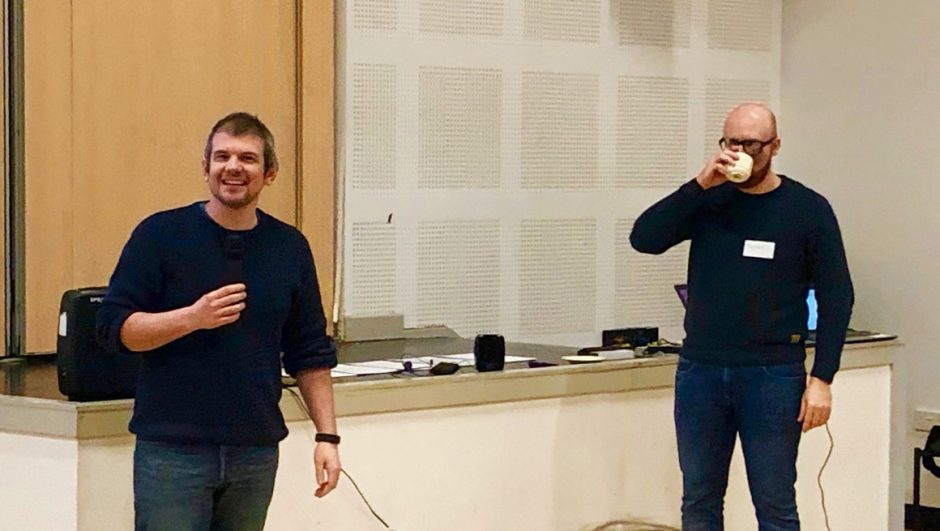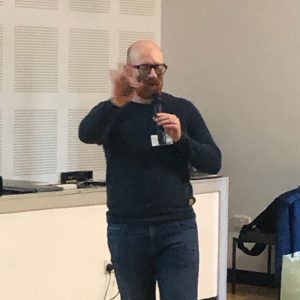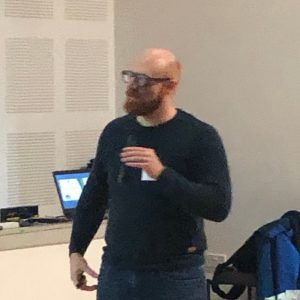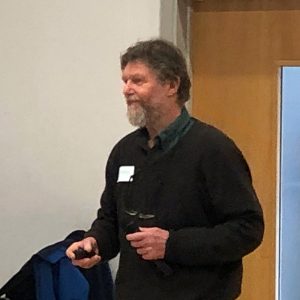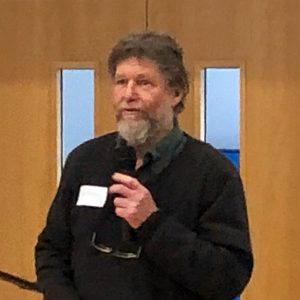Over 70 members attended our 3rd Annual Meeting (again at Loch Leven Community Campus, Kinross), renewing friendships and meeting fellow beekeepers who shared their passion for the native honey bee. Andrew Abrahams and Dylan Elen were our guest speakers while Gavin Ramsay (SNHBS chair) gave the latest news on the Conservation Project and led the business meeting.
Andrew is already well known for his work establishing the dark native honey bee reserve on Colonsay and Dylan brought us fascinating news of his research in Wales and the conservation of the dark bee in Belgium. Together our speakers took us on a journey from home ground to the other side of the world looking at honey bee survival.
[Dylan Elan]
Dylan related how he showed an interest in insects from a very young age, eventually becoming a beekeeper as well as scientist. He is now the president of ZwarteBij.org a Belgian trust for the conservation of their local dark bee. At first, in his home country, he thought the only bees were Carniolans until he attended a conference on different honey bee races in 2010 and was intrigued by this. In 2012 he had his first dark bees and worked hard to develop a gentle strain and encourage others to realise their conservation value. Breeding was rigorously planned using the best drones, controlled mating stations and the resulting queens tested in three different environments to compare gentleness, productivity and Varroa tolerance. The next step was to provide good stock to members. Dylan also spoke of ‘conservation through re-wilding’ where ‘survival’ genes are encouraged.
Andrew described how the original dark honey bee had been taken to Tasmania in 1831 on a six-month voyage testing it to the limits and yet it survived and went on to colonise its new home and show its ability to adapt. Tasmania has areas of mountains and high rainfall in a maritime climate very much like the west of Scotland and expanses of Eucalyptus forest which made a natural home for the bees. Later commercial beekeepers imported yellow Italian strains which struggled with the changeable weather and often required heavy feeding to survive. Overall the dark bees were the best adapted to the harder conditions in the central highlands. It was recognised that a reserve area (Tarraleah) with indigenous forest was essential to conserve stocks of dark bees and ensure there were enough drones flying to preserve good genes. The protection of remaining forests was an important move but it is also evident that the black bee does best in the windy and drier east of the island.
[Andrew Abrahams]
Kangaroo Island, just 15 miles off the coast south of Adelaide, is a special reserve for Ligurian honey bees with strict controls in place. However later research had shown that the dark bee had been there in the past. Andrew also spoke of Tom Seeley’s work on wild swarms in the Arnot Forest, New York State, USA from the 1970s and how the spread of Varroa had caused a population collapse with re-establishment of a wild population able to cope with Varroa 30 years later. Over 350 years ago Apis mellifera mellifera dark bees were taken to North America by European settlers but were largely replaced by much later importations of Ligustica and Carniolans. DNA studies show that even now the influence of Amm remains a testament to its ability to survive.
Gavin Ramsay then reported on the Conservation Project which was launched by SNHBS with the benefit of thorough planning by Ian Lennox. The project aim was to find what is available in Scotland apart from the excellent stocks on Colonsay. A strict protocol based on visual assessment was used by four trained assessors to score and rank digital images sent by beekeepers. These assessments achieved consistent results between assessors looking at body integument colour, thorax hair colour, tomental band width and hair length over the distal end of the abdomen. The samples which were scored as the best native types together with a subset of non-assessed lines were sent to Aarhus University, Denmark for DNA studies by the kind agreement of Per Kryger. Wing morphometry was then checked by Fred Mollison on all stored samples. Although DNA data for individual, numbered colonies was not available for the meeting, key examples were presented of colonies that did not fit Apis mellifera mellifera on either the four traits or wing morphometry, colonies that appeared to fit one or the other only, and colonies that appear to fit Amm on both of these criteria. This served as a useful reminder that wing morphometry alone is not sufficient to discriminate bee subspecies. It was reassuring that there was much material across the country that was close to the native type but also worrying that a complete fit to the ideal as represented by Colonsay samples was hard to find. The presence of many near-native lines in Scotland was confirmed by an overall analysis of the DNA data that had been performed in Denmark and was presented by Ewan Campbell at the meeting. We are looking forward to being able to link DNA data with the other scores amassed on the same colonies using DNA scores on individual samples finally delivered to us in early July 2019.
A brief business meeting was held during which the financial report was presented and our Board of Trustees was enhanced by Margaret Packer, Helena Jackson, Alistair Sharp and Alan Kain, with Jeff Baxter and Ewan Campbell standing aside on the day to make space on the Board together with the resignations of Em Mackie and Kelly Dyer. We are very grateful to all four for their efforts in getting our society off the ground and to our new trustees for their willingness to offer us their energy and skills!
[Header photo: Ewan Campbell and Dylan Elan]
By John Durkacz and Gavin Ramsay

